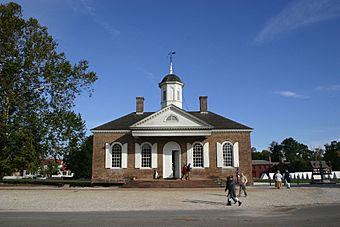Courthouse (Colonial Williamsburg) facts for kids
Quick facts for kids |
|
|
Colonial Williamsburg Courthouse
|
|
|
U.S. National Historic Landmark District
Contributing Property |
|

The courthouse in Colonial Williamsburg
|
|
| Location | Duke of Gloucester Street between Palace Green and Queen Street |
|---|---|
| Built | 1771 |
| Architectural style | Georgian style |
| Part of | Williamsburg Historic District (ID66000925) |
| Designated NHLDCP | October 15, 1966 |
The Colonial Williamsburg Courthouse is a very old and important building. It was built between 1770 and 1771. This historic courthouse is located in Colonial Williamsburg, facing Market Square. It is a great example of the Georgian style of building.
The courthouse became part of Colonial Williamsburg in 1928. It was added to the National Register of Historic Places on October 15, 1966. This means it is recognized as a special historic place in the Williamsburg Historic District.
What is the Courthouse?
A courthouse is a place where legal cases are heard. This building once held two different court systems. One was the James City County Court. It handled legal cases for the surrounding county. The other was the Hustings Court. This court took care of cases for the city itself.
Building Features
The Colonial Williamsburg Courthouse is made of red bricks. It has white wooden trim around its windows and doors. The windows are tall and arched, with white shutters. A special covered entrance, called a portico, sticks out from one side. This design was quite unique for Georgian buildings.
The roof of the courthouse is shaped like a hip. It has decorative moldings called dentils. You can see chimneys on both sides of the roof. In the very center, there is an eight-sided tower. This tower has a dome on top, finished with a tall spire.
Important Moments in History
This courthouse played a big role in American history. On July 25, 1776, the United States Declaration of Independence arrived from Philadelphia. A man named Benjamin Waller stood outside the courthouse. He read the Declaration aloud to the people gathered there. This was a very exciting moment for the community.
Later, during the American Civil War, the building was used differently. After the Battle of Williamsburg, it became a hospital. It helped care for soldiers from the Confederate States Army.
- Beney, Peter; The Majesty of Colonial Williamsburg; Pelican Books; Gretna, Louisiana; 1997 ISBN: 0-88289-993-7


